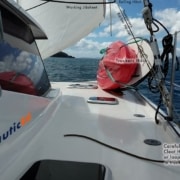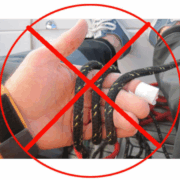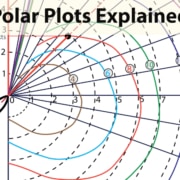Pinching – Feel the boat talk to you
Take notice as the boat stands up and heels over
Last night I was at a sailing group meeting in Austin, Texas. One of the ladies mentioned to me that she was having trouble determining if the boat was pinching or not. Pinching is a term to describe the boat heading too close to the wind. Some one is usually doing this if they are trying to sail to a destination that is too close to where the wind is coming from. When you do this your boat speed reduces dramatically and you’re better off bearing away from your destination, picking up speed and tacking one last time to your destination.
Anyway, the answer pretty much flew out of my mouth before thinking and it was to feel the boat. I got a quizzing look and so thus begins todays teaching. And as usual – I came up with a cool html5 animation to lead you through it. This animation and the explanation is embedded into the NauticEd Skipper Sailing Course. This Skipper course is equivalent to a 101 type course except that is is far more in-depth and of course isn’t a boring ol paper book lacking multimedia animations. If you’re newish to sailing or want a jolly good brush up, then take the skipper sailing course.
Ok on with the lesson: When you start pinching, the apparent wind will be less than 30 deg off the bow of the boat. It means you’re heading too close to the origin of the wind and that the wind can not provide lift and pressure properly on the sails. With no pressure, the heeling force is reduced and so the boat literally “stands up” straight. So the scenario is that you’re sailing along, heeling over and you begin to feel the boat stand up straight. It’s a good indication that you’re starting to pinch and you’ll need to bear away.
Go through the html5 animation below.
The concept of increased wind speed and changing course will potentially bamboozle you. If it does, I highly recommend that you take the NauticEd free basic sail trim course to gain a better understanding of true and apparent wind and how the apparent wind changes direction when the true wind only increases or decreases in speed. This will show you that when the true wind speed changes, you’ll need to make a course correction as well. And it just so happens that when the wind gets lighter – you need to bear away in the same manner if the wind actually shifted forward. So in both cases wind shifting forward or getting lighter you need to bear away. Thus automatically then. if you feel the boat standing up – bear away. If you feel the boat heeling more, steer up.
Some wind shift definitions:
- Wind shifting forward – this means the wind that you feel comes now more from the front of the boat.
- Wind shifting aft – this means that the wind that you feel comes now more from the stern.
- Wind veering – means wind changes in a clockwise direction – e.g. if it was a north easter then a veered wind might be an easterly.
- Wind backing – means wind changes in a counter-clockwise direction – e.g. if it was a north easter then a backed wind might be an northerly.
This animation and many others are embedded into the Skipper course. This is basic stuff and is meant for the novice student. If this is something you didn’t automatically know then it’s a good indication you should learn a lot more about sailing by taking the NauticEd Skipper course.
Start working towards your Skipper Sailing Certificate by taking the Skipper Sailing Course now!









